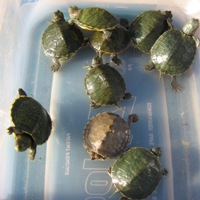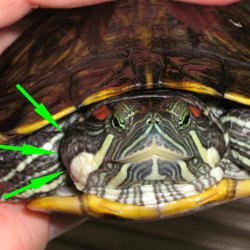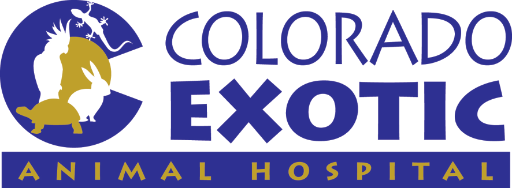Basic Care: Red-eared Slider
Red-eared sliders are the most popular aquatic turtle kepts as pets. The commercial sales of baby turtles to the public is illegal due to the "4-inch law" regulated by the Food and Drug Administration (Title 21, Part 1240.62 of the Code of Federal Regulations 21 CFR 1240.62 (b) and Compliance Policy Guide 7129.01). This law does not ban the sales of baby turtles from one hobbyist to another. It also does not ban the sale of turtles that are at least 4" long and you may find healthy red-eared sliders for sale in reputable pet stores.

Baby red-eared sliders and a map turtle for sale by a roadside vendor. There is no water in their container and the air temperature was 50°F when this photo was taken.
Red-eared sliders are often sold by unscrupulous people by the side of the road. In Arizona, this practice is illegal per Arizona Revised Statues under title 44 section 1799.71. These tiny turtles have often gone through terrible conditions between the time they hatched and when they finally ended up in your hands. As a result, many of these baby turtles are destined to die within a few weeks to a few months of being purchased even if you do everything right! DO NOT BUY TURTLES FROM ROADSIDE VENDORS!
Baby Turtle Care
Baby red-eared sliders need a lot more care and attention than adult turtles. A 10 gallon tank is an adequate starter size for a baby red-eared slider but there are a variety of other enclosures that work just as well. Large dishpans, mortar tubs, Waterland turtle tubs, and Rubbermaid containers, are among the many things that work as turtle homes.
The water should be deep enough a turtle can easily flip itself to a normal position if it gets turned upside-down. Ideally the water should be filtered with a 10 to 20% water change performed weekly to help keep it clean. Foam filters or canister filters work well. Uneaten food and feces should be removed on a daily basis. The water temperature should be warm, at least 80°F for healthy babies and at least 85°F for babies that are not eating well or show other signs of ill health. A submersible heater used for tropical fish tanks works well with small turtles as do some of the waterproof heat pads that can be placed underneath the tank. There are many different water conditioners sold for water turtles but aged tap water works quite well for red-eared sliders.
A basking platform that sits above the water line is essential. This platform should allow the turtle to easily climb out of the water or hang on the edge of the platform and float at the water's surface. Cork bark, floating wood, and sturdily stacked rocks are good choices as are the floating platforms sold in pet stores. A bright white light should be focused on the basking platform and provide a temperature of 90-95°F throughout the day (at least 10-12 hrs of light a day). A red basking light or ceramic heat element should be on at night to keep the basking spot around 85-90°F. During the day, a second bulb is needed to provide ultraviolet-B for at least 8 hrs a day. This ultraviolet-B, often simply abbreviated as UVB, is essential for normal bone development and the overall health and normal behavior of a baby red-eared slider. Zoomed's Reptisun and Powersun are excellent choices for providing UVB.
Baby red-eared sliders normally have voracious appetites. Sometimes they are stimulated to eat by moving things, such as live crickets, minnows, bloodworms, or earthworms, but they usually settle into a diet of prepared foods such as a high quality aquatic turtle pellet, frozen and thawed chopped minnows, chopped earthworms, and small amounts of chopped green leafy vegetables. Most aquatic turtle pellets are excellent sources of protein and calcium. Ferret kibble, kitten chow, and trout chow have also been used with good success as part of a red-eared slider's diet. It is extremely important to provide a balanced diet as calcium deficiency (also known as metabolic bone disease or nutritional secondary hyperparathyroidism) and low levels of vitamin A are common causes of poor health in growing red-eared sliders.
If your baby turtles develops swollen eyes, bubbles from the nose, floats a lot or has trouble submerging or surfacing, has a poor appetite, or simply doesn't swim around much or it sits on the basking platform all day, it is sick and needs veterinary attention.

The green arrows point to a swollen ear in this young red-eared slider. You can see the other ear is also swollen. This "aural abscess" requires surgical treatment.
For more in-depth slider care visit: https://reptifiles.com/red-eared-slider-care/

